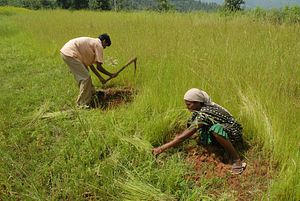The posh conversations about organic food that started off in the West and reached even the rich circles of India some years ago must stop. They work on a capitalistic model of profit and gain and lack a basic understanding of what “organic” essentially means. The entire dialogue reducing organic food to “food without chemicals” has been a clever ruse to keep encouraging harmful ways of agriculture, which has destroyed rural communities and vulnerable agricultural communities in developing countries in the process.
Agricultural traditions in most of the northern plains in India have already been destroyed by the cash crop and hybrid seeds frenzy during and after the Green Revolution, which started in the 1950s. Of late, the marginal belts and a few interior pockets that remained untouched are also under a lot of stress. Tribal communities in India have been the last barrier against the devious onslaught of unnatural and ecologically unfit agricultural practices, but things have started changing there as the markets close in on them. There is tremendous pressure not only to shift from food crops to cash crops; most of the food crops are also treated as cash crops now.
In this problematic scenario, I found an interesting experiment being run in the eastern Indian state of Odisha, in its south tribal belt. A local NGO, Living Farms, which works to promote tribal traditions and culture through food, regularly organizes food festivals for tribal people in their villages. Clearly different from the hullabaloo of city food festivals, these festivals aim to acquaint the youth of the diversity of their food and to remind older people what they risk to lose.
In 2012, during a public meeting, an old lady stood up and complained that the younger generations of her Kondh tribe have stopped eating ragi (millets) and that she can see that it will lead to the demise of her community. It was a clear signal that the community elders were aware of what is at stake and had started analyzing the damage being caused by market forces.
In 2013, at their first food festival, Living Farms displayed a whole range of food items that were traditionally grown by the Kondh tribe people, or procured from the forests and cooked by them. A grandmother walked up to the huge display and asked her grandson: “look at all the food, do you think we are poor?” The statement is a clear rebuke of government planning managers, who introduce so-called “development” schemes for India’s tribal people without understanding what development should mean.
While the planning commission works on a biased and shallow understanding of India’s tribal people, market forces are more insidious. There is a clear effort to de-tribalize these communities so that the hills are open to mining companies for minerals and farms are open to hybrid seed companies, chemical companies, and banks. To gain entry, it is important to break the underlying philosophy of life that keeps the communities together.
Once they stop growing locally viable heirloom varieties of millet and many others along with it, market forces take over, granting entry for hybrid seeds, pesticides, fertilizers, money, loans, and hyper individuality. It leads to the total destruction of a community. Debjeet Sarangi of Living Farms says, “Once the relationship with the land and forest is lost, tribal people – poor without their land and food, make for easy insecure, unskilled, and unorganized labour to work in the cities as well. Instead of tapping their knowledge resources on forests and agriculture, we encourage brain drain and that is a huge loss,” he adds.
That brings us back to the question of what exactly qualifies as organic. Many companies promoting organic food boast that they discourage use of pesticides, and hence promote safe agriculture. All this, of course, while they systematically promote monoculture agriculture. Monoculture makes crops vulnerable to pests, while drastically affecting the food dependency of agricultural communities to buying rest of the food for nutritional requirements. It works on the same model of pressurizing farmers to produce more and more of a single type of crop for maximum benefits.
In effect, it is replacing one flawed system with another deeply ecologically unfit system. For instance, the huge costs of transporting pesticide-free quinoa from South America, which is neither indigenous to North America, Europe, or Asia, also adds carbon footprint to the crop and increases the cost for consumers. These unviable systems do not look at the nutritional requirements of the poor of the world either.
Organic foods evolved in a particular landscape and environment, and the man evolved to survive on those particular food items in that particular environment. It was indigenous. It was about the coexistence of man and nature, and of a close bonding between the both. It is time we reclaim our sense of belonging, solidarity, and relationship with our ecology.

































